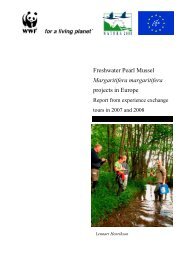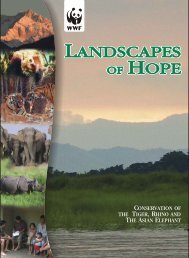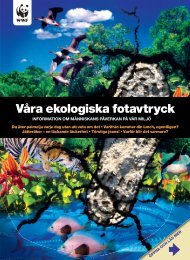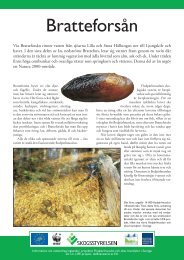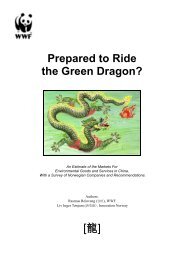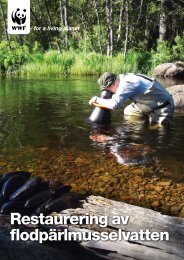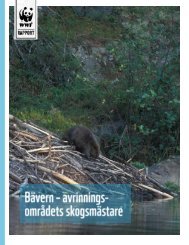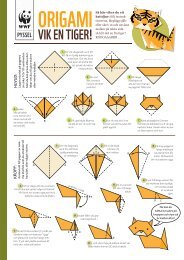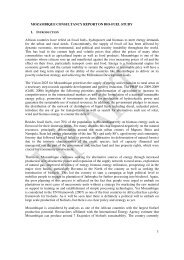Generell hänsyn och naturvärdesindikatorer - SLU
Generell hänsyn och naturvärdesindikatorer - SLU
Generell hänsyn och naturvärdesindikatorer - SLU
- No tags were found...
You also want an ePaper? Increase the reach of your titles
YUMPU automatically turns print PDFs into web optimized ePapers that Google loves.
ReferenserJoensuu, S., Ahti, E. & Vuollekoski, M. (2002) Effectsof ditch network maintenance on the chemistry of runoffwater from peatland forests. Scandinavian Journalof Forest Research 17:238-247Johansson, T., Gibb, H., Hilszczański, J., Pettersson,R.B., Hjältén, J., Atlegrim, O., Ball, J.P. & Danell, K.(2006) Conservation-oriented manipulations of coarsewoody debris affect its value as habitat for spruce-infestingbark and ambrosia beetles (Coleoptera: Scolytinae)in northern Sweden. Canadian Journal of ForestResearch 36:174-185Johansson, T., Hjältén, J., Gibb, H., Hilszczański,J., Stenlid, J., Ball, J.P., Alinvi, O. & Danell, K. (2007)Variable response of different functional groups of saproxylicbeetles to substrate manipulation and forestmanagement: implications for conservation strategies.Forest Ecology and Management 242:496-510Jonsell, M. (2003) Hotade insekter i tickor kan ge vägledningi naturvårdsarbetet. Fakta Skog 2003:1-4Jonsell, M. (2007) The effects of biofuel harvest on biodiversity- a synthesis with focus on the Nordic-Balticregion. In: Röser D, Asikainen A, Raulund-RasmussenK, Møller IS (eds) The effects of biofuel harvest on biodiversity.SpringerJonsell, M., Schroeder, L.M. & Weslien, J. (2005) Saproxylicbeetles in high stumps of spruce: Fungal floraimportant for determining the species composition.Scandinavian Journal of Forest Research 20:54-62Jonsell, M. & Weslien, J. (2003) Felled or standing retainedwood - it makes a difference for saproxylic beetles.Forest Ecology and Management 175:425-435Jonsson, B.G. & Jonsell, M. (1999) Exploring potentialbiodiversity indicators in boreal forests. Biodiversityand Conservation 8:1417-1433Juutinen, A. & Mönkkönen, M. (2004) Testing alternativeindicators for biodiversity conservation in oldgrowthboreal forests: ecology and economics. EcologicalEconomics 50:35-48Juutinen, A., Mönkkönen, M. & Sippola, A.L. (2006)Cost-efficiency of decaying wood as a surrogate foroverall species richness in boreal forests. ConservationBiology 20:74-84Jönsson, M.T. & Jonsson, B.G. (2007) Assessing coarsewoody debris in Swedish woodland key habitats: Implicationsfor conservation and management. ForestEcology and Management 242:363-373Kalwij, J.M., Wagner, H.H. & Scheidegger, C. (2005)Effects of stand-level disturbances on the spatial distributionof a lichen indicator. Ecological Applications15:2015-2024Karström, M. (1992) Steget före - en presentation.Svensk Botanisk Tidskrift 86:103-114Kellner, O. (1993) Effects on associated flora of silviculturalnitrogen fertilization repeated at long intervals.Journal of Applied Ecology 30:563-574Kempe, A. (1998) Miljöhänsyn vid föryngringsavverkning.Meddelande 4 - 1998. Skogsstyrelsen, JönköpingKomonen, A., Niemi, M.E. & Junninen, K. (2008) Lakesideriparian forests support diversity of wood fungiin managed boreal forests. Canadian Journal of ForestResearch 38:2650-2659Komonen, A., Penttilä, R., Lindgren, M. & Hanski,I. (2000) Forest fragmentation truncates a food chainbased on an old-growth forest bracket fungus. Oikos90:119-126Kouki, J., Lofman, S., Martikainen, P., Rouvinen, S.& Uotila, A. (2001) Forest fragmentation in Fennoscandia:Linking habitat requirements of wood-associatedthreatened species to landscape and habitat changes.Scandinavian Journal of Forest Research:27-37Kreutzweiser, D.P., Good, K.P., & Sutton, T.M. (2005)Large woody debris characteristics and contribution topool formation in forest streams of the Boreal Shield.Canadian Journal of Forest Research 35:1213-1223Kreyer, D. & Zerbe, S. (2006) Short-lived tree speciesand their role as indicators for plant diversity inthe restoration of natural forests. Restoration Ecology14:137-147Kuuluvainen, T. (2002) Natural variability of forests as areference for restoring and managing biological diversityin boreal Fennoscandia. Silva Fennica 26:97-125Kuuluvainen, T., Aapala, K., Ahlroth, P., Kuusinen,M., Lindholm, T., Sallantaus, T., Siitonen, J. & Tukia,H. (2002) Principles of ecological restoration of borealforested ecosystems: Finland as an example. Silva Fennica26:409-422Larsson, S. & Danell, K. (2001) Science and the managementof boreal forest biodiversity. ScandinavianJournal of Forest Research Supplement 3:5-9Lazaruk, L.W., Kernaghan, G., Macdonald, S.E. &Khasa, D. (2005) Effects of partial cutting on the ectomycorrhizaeof Picea glauca forests in northwesternAlberta. Canadian Journal of Forest Research 35:1442-1454Lemieux, J.P. & Lindgren, B.S. (2004) Ground beetleresponses to patch retention harvesting in high elevationforests of British Columbia. Ecography 27:557-566Lilja, S., De Chantal, M., Kuuluvainen, T., Vanha-Majamaa,I. & Puttonen, P. (2005) Restoring natural characteristicsin managed Norway spruce [Picea abies(L.)Karst.] stands with partial cutting, dead wood creationand fire: immediate treatment effects. ScandinavianJournal of Forest Research Supplement 6 20:68-78Lindberg, N. & Persson, T. (2004) Effects of long-termnutrient fertilisation and irrigation on the microarthropodcommunity in a boreal Norway spruce stand. ForestEcology and Management 188:125-135Lindenmayer, D.B. (1999) Future directions for biodiversityconservation in managed forests: indicator species,impact studies and monitoring programs. ForestEcology and Management 115:277-287Lindenmayer, D.B., Franklin, J.F. & Fischer, J. (2006)General management principles and a checklist of strategiesto guide forest biodiversity conservation. BiologicalConservation 131:433-445Lindenmayer, D.B., Manning, A.D., Smith, P.L., Possingham,H.P., Fisher, J., Oliver, I. & McCarthy, M.A.(2002) The focal species approach and landscape restoration:a critique. Conservation Biology 16:338-345Lindenmayer, D.B., Margules, C.R. & Botkin, D.B.(2000) Indicators of biodiversity for ecologically sustainableforest management. Conservation Biology14:941-950Linder, P., Elfving, B. & Zackrisson, O. (1997) Standstructure and successional trends in virgin boreal forestreserves in Sweden. Forest Ecology and Management98:17-33Linder, P. & Östlund, L. (1992) Förändringar i norraSveriges skogar 1870-1991. Svensk Botanisk Tidskrift86:199-215Linder, P. & Östlund, L. (1998) Structural changes inthree mid-boreal Swedish forest landscapes, 1885-1996. Biological Conservation 85:9-19Lindhe, A., Lindelöw, Å. & Åsenblad, N. (2005) Saproxylicbeetles in standing dead wood - density in relationto substrate sun-exposure and diameter. Biodiversityand Conservation 14:3033-3053Lindhe, A., Åsenblad, N. & Toresson, H-G. (2004) Cutlogs and high stumps of spruce, birch, aspen and oak- nine years of saproxylic fungi succession. BiologicalConservation 119:443-454Lloyd, P., Martin, T.E., Redmond, R.L., Langner,U. & Hart, M.M. (2005) Linking demographic effectsof habitat fragmentation across landscapes to continentalsourcesink dynamics. Ecological Applications15:1504-1514Lonsdale, D., Pautasso, M. & Holdenrieder, O. (2008)Wood-decaying fungi in the forest: conservation needsand management options. European Journal of ForestResearch 127:1-22Malanson, G.P. (1993) Riparian landscapes. CambridgeUniversity PressMaleque, M.A., Ishii, H.T. & Maeto, K. (2006) The use ofarthropods as indicators of ecosystem integrity in forestmanagement. Journal of Forestry 104:113-117Markusson, K. (1998) Omgivande skog <strong>och</strong> skogsbruketsbetydelse för fiskfaunan i små skogsbäckar.Skogsstyrelsen, JönköpingMartikainen, P., Siitonen, J., Kaila, L. & Punttila, P.(1996) Intensity of forest management and bark beetlesin non-epidemic conditions: A comparison betweenFinnish and Russian Karelia. Journal of AppliedEntomology-Zeitschrift Fur Angewandte Entomologie120:257-264Martikainen, P., Siitonen, J., Punttila, P., Kaila, L. &Rauh, J. (2000) Species richness of Coleoptera in maturemanaged and old-growth boreal forests in southernFinland. Biological Conservation 94:199-209Mazurek, M.J. & Zielinski, W.J. (2004) Individuallegacy trees influence vertebrate wildlife diversity incommercial forests. Forest Ecology and Management193:321-334McGe<strong>och</strong>, M.A., Schroeder, M., Ekbom, B. & Larsson,S. (2007) Saproxylic beetle diversity in a managedboreal forest: importance of stand characteristics andforestry conservation measures. Diversity and Distributions13:418-429McLaren, M.A., Thompson, I.D. & Baker, J.A. (1998)Selection of vertebrate wildlife indicators for monitoringsustainable forest management in Ontario. ForestryChronicle 74:241-248Mikusinski, G., Gromadzki, M. & Chylarecki, P. (2001)Woodpeckers as indicators of forest bird diversity. ConservationBiology 15:208-217Mladenoff, D.J., White, M.A., Pastor, J. & Crow, T.R.(1993) Comparing spatial patterns in unaltered oldgrowthand disturbed forest landscapes. Ecologicalapplications 3:294-306Moen, C.A. & Gutierrez, R.J. (1997) California spottedowl habitat selection in the central Sierra Nevada.Journal of Wildlife Management 61:1281-1287Naiman, R.J., Déchamps, H. & McClain, M.E. (2005)Riparia. ecology, conservation, and management ofstreamside communities. Elsevier Academic Press,AmsterdamNaturvårdsverket. (1993) Indikatorarter för identifieringav naturskogar i Norrbotten. Rapport 4276. Naturvårdsverket,SolnaNaturvårdsverket. (2007) Status, potential <strong>och</strong> kvalitetskravför sjöar, vattendrag, kustvatten <strong>och</strong> vatten iövergångszon. En handbok om hur kvalitetskrav i ytvattenförekomsterkan bestämmas <strong>och</strong> följas upp. Naturvårdsverketshandbok 2007:4Nguyen-Xuan, T., Bergeron, Y., Simard, D., Fyles,J.W. & Paré, D. (2000) The importance of forest floordisturbance in the early regeneration patterns of theboreal forest of western and central Quebec: a wildfireversus logging comparison. Canadian Journal of ForestResearch 30:1353-1364Nicholls, K.H., Steedman, R.J. & Carney, E.C. (2003)Changes in phytoplankton communities following loggingin the drainage basins of three boreal forest lakesin northwestern Ontario (Canada), 1991-2000. CanadianJournal of Fisheries and Aquatic Sciences 60:43-54Niemelä, J. (1997) Invertebrates and boreal forest management.Conservation Biology 11:601-610Niemelä, T., Renvall, P. & Penttilä, R. (1995) Interactionsof fungi at late stages of wood decomposition.Annales Botanici Fennici 32:141-152Nieminen, J.K. & Setälä, H. (2001) Influence of carbonand nutrient additions on a decomposer food chain andthe growth of pine seedlings in microcosms. AppliedSoil Ecology 17:189-197Niklasson, M. & Drakenberg, B. (2001) A 600-yearthree ring fire history from Norra Kvills National park,southern Sweden: implications for conservation strategiesin the hemiboreal zone. Biological conservation101:63-71Nilsson, S.G. (1997) Biologisk mångfald under tusenår i det sydsvenska kulturlandskapet. Svensk BotaniskTidskrift 91:85-101Nilsson, S.G., Hedin, J. & Niklasson, M. (2001) Biodiversityand Its Assessment in Boreal and Nemoral Forests.Scandinavian Journal of Forest Research:10-26Nitare, J. (2000) Signalarter: indikatorer på skyddsvärdskog: flora över kryptogamer, 2 edn. Skogsstyrelsensförlag, Jönköping, SwedenNordén, B. & Appelqvist, T. (2001) Conceptual problemsof Ecological Continuity and its bioindicators.Biodiversity and Conservation 10:779-791Nordén, B. & Paltto, H. (2001) Wood-decay fungi in hazelwood: species richness correlated to stand age and deadwood features. Biological Conservation 101:1-8Nordén, B., Paltto, H., Götmark, F. & Wallin, K. (2007)Indicators of biodiversity, what do they indicate? - Lessonsfor conservation of cryptogams in oak-rich forest.Biological Conservation 135:369-379Nordin, A., Strengbom, J., Witzell, J., Näsholm, T. &Ericson, L. (2005) Nitrogen deposition and the biodiversityof boreal forests: implications for the nitrogencritical load. Ambio 34:20-24Nordlind, E. & Östlund, L. (2003) Retrospective comparativeanalysis as a tool for ecological restoration: a casestudy in a Swedish boreal forest. Forestry 76:243-251Norén, M., Nitare, J., Larsson, A., Hultgren, B. & Bergengren,I. (2002) Handbok för inventering av nyckelbiotoper.Skogsstyrelsen, JönköpingNyberg, P. & Eriksson, T. (2001) Skyddsridåer längsvattendrag (SILVA). Fiskeriverket, GöteborgNäslund, I. (1999) Fiske, skogsbruk <strong>och</strong> vattendrag –nyttjande i ett uthålligt perspektiv. Ammeråprojektet.Fiskeriverket, StockholmOhlson, M., Söderström, L., Hörnberg, G., Zackrisson,O. & Hermansson, J. (1997) Habitat qualitiesversus long-term continuity as determinants of biodiversityin boreal old-growth swamp forests. BiologicalConservation 81:221-231Ojala, E., Mönkkönen, M. & Inkeröinen, J. (2000)Epiphytic bryophytes on European aspen Populus tremulain old-growth forests in northeastern Finland andin adjacent sites in Russia. Canadian Journal of Botany78:529-536Olsson, J. (2009) Hänsyn till skogsvattendrag – en fallstudie.WWF, StockholmOuterbridge, R.A. & Trofymow, J.A. (2004) Diversityof ectomycorrhizae on experimentally planted Douglas-firseedlings in variable retention forestry siteson southern Vancouver Island. Canadian Journal ofBotany 82:1671-1681Paltto, H., Norden, B., Götmark, F. & Franc, N. (2006) Atwhich spatial and temporal scales does landscape contextaffect local density of Red Data Book and Indicatorspecies? Biological Conservation 133:442-454Pasinelli, G. (2000) Oaks (Quercus sp.) and only oaks?Relations between habitat structure and home rangesize of the middle spotted woodpecker (Dendrocoposmedius). Biological Conservation 93:227-235Pawson, S.M., Brockerhoff, E.G., Norton, D.A. &Didham, R.K. (2006) Clear-fell harvest impacts onbiodiversity: past research and the search for harvestsize thresholds. Canadian Journal of Forest Research36:1035-1046Pearman, P.B. & Weber, D. (2007) Common speciesdetermine richness patterns in biodiversity indicatortaxa. Biological Conservation 138:109-119Penteriani, V. (2002) Goshawk nesting habitat in Europeand North America: a review. Ornis Fennica 79:149-163Penttilä, R., Siitonen, J. & Kuusinen, M. (2004) Polyporediversity in managed and old-growth boreal Piceaabies forests in southern Finland. Biological conservation117:271-283Perhans, K., Gustafsson, L., Jonsson, F., Nordin, U.& Weibull, H. (2007) Bryophytes and lichens in differenttypes of forest set-asides in boreal Sweden. ForestEcology and Management 242:374-390Pohl, G.R., Langor, D.W. & Spence, J.R. (2007) Rovebeetles and ground beetles (Coleoptera: Staphylinidae,Carabidae) as indicators of harvest and regenerationpractices in western Canadian foothills forests. BiologicalConservation 137:294-307Pontailler, J.Y., Faille, A. & Lemee, G. (1997) Stormsdrives successional dynamics in natural forests: a casestudy in Fontainebleau forest (France). Forest Ecologyand Management 98:1-15Potvin, F. & Bertrand, N. (2004) Leaving forest stripsin large clearcut landscapes of boreal forest: A managementscenario suitable for wildlife? The ForestChronicle 80:44-53Pykälä, J., Heikkinen, R.K., Toivonen, H. & Jääskeläinen,K. (2006) Importance of Forest Act habitats forepiphytic lichens in Finnish managed forests. ForestEcology and Management 223:84-92Ranius , T. (2000) Minimum viable population size ofa beetle, Osmoderma eremita, living in tree hollows.Animal Conservation 3:37-43Ranius, T. (2002a) Influence of stand size and qualityof tree hollows on saproxylic beetles in Sweden. BiologicalConservation 103:85-91Ranius, T. (2002b) Osmoderma eremita as an indicatorof species richness of beetles in tree hollows. Biodiversityand Conservation 11:931-941Ranius, T. & Jansson, N. (2000) The influence of forestregrowth, original canopy cover and tree size onsaproxylic beetles associated with old oaks. BiologicalConservation 95:85-94Ranius, T. & Kindvall, O. (2004) Modelling the amount ofcoarse woody debris produced by the new biodiversityorientedsilvicultural practices in Sweden. BiologicalConservation 119:51-59Ranius, T. & Kindvall, O. (2006) Extinction risk of woodlivingmodel species in forest landscapes as related toforest history and conservation strategy. LandscapeEcology 21:687-698Ranius, T., Kindvall, O., Kruys, N. & Jonsson, B.G.(2003) Modelling dead wood in Norway spruce standssubject to different management regimes. Forest Ecologyand Management 182:13-29Reich, P.B., Bakken, P., Carlson, D., Frelich, L.E.,Friedman, S.K. & Grigal, D.F. (2001) Influence of logging,fire, and forest type on biodiversity and productivityin southern boreal forests. Ecology 82:2731-2748Renvall, P. (1995) Community structure and dynamics ofwood-rotting Basidiomycetes on decomposing conifertrunks in northern Finland. Karstenia 35:1-51Reunanen, P., Mönkkönen, M. & Nikula, A. (2000)Managing boreal forest landscapes for flying squirrels.Conservation Biology 14:218-226Ricketts, T.H., Daily, G.C. & Ehrlich, P.R. (2002) Doesbutterfly diversity predict moth diversity? Testing a popularindicator taxon at local scales. Biological Conservation103:361-370Ries, L., Fletcher, R.J.J., Battin, J. & Sisk, T.D. (2004)Ecological responses to habitat edges: mechanisms,models, and variability explained. Annual Review ofEcology, Evolution and Systematics 35:491-522Roberge, J-M. & Angelstam, P. (2004) Usefullness ofthe umbrella species concept as a conservation tool.Conservation Biology 18:76-85Roberge, J-M. & Angelstam, P. (2006) Indicator speciesamong resident forest birds - A cross-regionalevaluation in northern Europe. Biological Conservation130:134-147Rodewald, A.D. & Yahner, R.H. (2000) Bird communitiesassociated with harvested hardwood stands containingresidual trees. Journal of Wildlife Management64:924- 932Rolstad, J., Gjerde, I., Gundersen, V.S. & Saetersdal,M. (2002) Use of indicator species to assess forest continuity:a critique. Conservation Biology 16:253-257Rosenberg, D.M. & Resh, V.H. (1993) Freshwater biomonotoringand benthic macroinvertebrates. Chapman& Hall, New York, LondonRoss, B., Fredericksen, T., Ross, E., Hoffman, W.,Morrison, M.L., Beyea, J., Lester, M.B., Johnson,B.N. & Fredericksen, N.J. (2000) Relative abundanceand species richness of herpetofauna in forest standsin Pennsylvania. Forest Science 46:139-146Rydgren, K., Hestmark, G. & Ökland, R.H. (1998)Revegetation following experimental disturbance ina boreal old-growth Picea abies forest. Journal of VegetationScienceRykken, J.J., Capen, D.E. & Mahabir, S.P. (1997)Ground beetles as indicators of land type diversity inthe Green Mountains of Vermont. Conservation Biology11:522-530Saari, L., Åberg, J. & Swenson, J.E. (1998) Factorsinfluencing the dynamics of occurrence of the hazelgrouse in a fine-grained managed landscape. ConservationBiology 12:586-592Saetersdal, M., Gjerde, I. & Blom, H.H. (2005) Indicatorspecies and the problem of spatial inconsistencyin nestedness patterns. Biological Conservation122:305-316Saetersdal, M., Gjerde, I., Blom, H.H., Ihlen, P.G., Myrseth,E.W., Pommeresche, R., Skartveit, J., Solhoy, T.& Aas, O. (2003) Vascular plants as a surrogate speciesgroup in complementary site selection for bryophytes,macrolichens, spiders, carabids, staphylinids, snails,and wood living polypore fungi in a northern forest.Biological Conservation 115:21-31Saetre, P., Saetre, L.S., Brandtberg, P.O., Lundkvist,H. & Bengtsson, J. (1997) Ground vegetation compositionand heterogeneity in pure Norway spruce andmixed Norway spruce - birch stands. Canadian Journalof Forest Research 27:2034-2042Sandin, L. & Johnson, R.K. (2004) Local, landscapeand regional factors structuring benthic macroinvertebrateassemblages in Swedish streams. LandscapeEcology 19:501-514Saurola, P.L. (1997) The osprey (Pandion haliaetus)and modern forestry: A review of population trendsand their causes in Europe. Journal of Raptor Research31:129- 137Schieck, J. & Hobson, K.A. (2000) Bird communitiesassociated with live residual tree patches within cutblocks and burned habitat in mixedwood boreal forests.Canadian Journal of Forest Research 30:1281-1295Schieck, J., Stuart-Smith, K. & Norton, M. (2000) Birdcommunities are affected by amount and dispersion ofvegetation retained in mixedwood boreal forest harvestareas. Forest Ecology and Management 126:239-254Schmit, J.P., Mueller, G.M., Leacock, P.R., Mata, J.L.,Wu, Q.X. & Huang, Y.G. (2005) Assessment of tree speciesrichness as a surrogate for macrofungal speciesrichness. Biological Conservation 121:99-110Schroeder, L.M., Ranius, T., Ekbom, B. & Larsson,S. (2006) Recruitment of saproxylic beetles in highstumps created for maintaining biodiversity in a borealforest landscape. Canadian Journal of Forest Research36:2168-2178Schroeder, L.M., Weslien, J., Lindelöw, Å. & Lindhe,A. (1999) Attacks by bark- and wood-boring Coleopteraon mechanically created high stumps of Norway sprucein the two years following cutting. Forest Ecology andManagement 123:21-3048 | GENERELL HÄNSYN OCH NATURVÄRDESINDIKATORER – Världsnaturfonden WWF Världsnaturfonden WWF – GENERELL HÄNSYN OCH NATURVÄRDESINDIKATORER | 49



